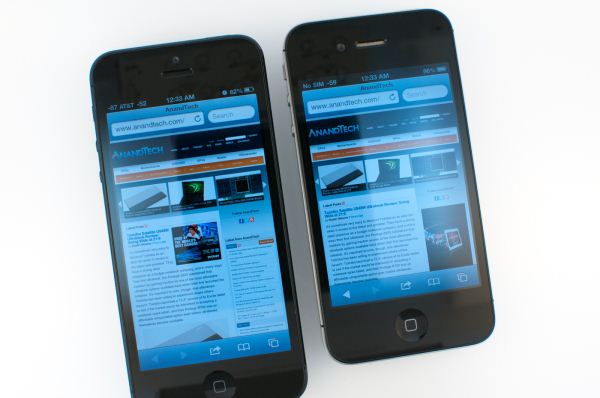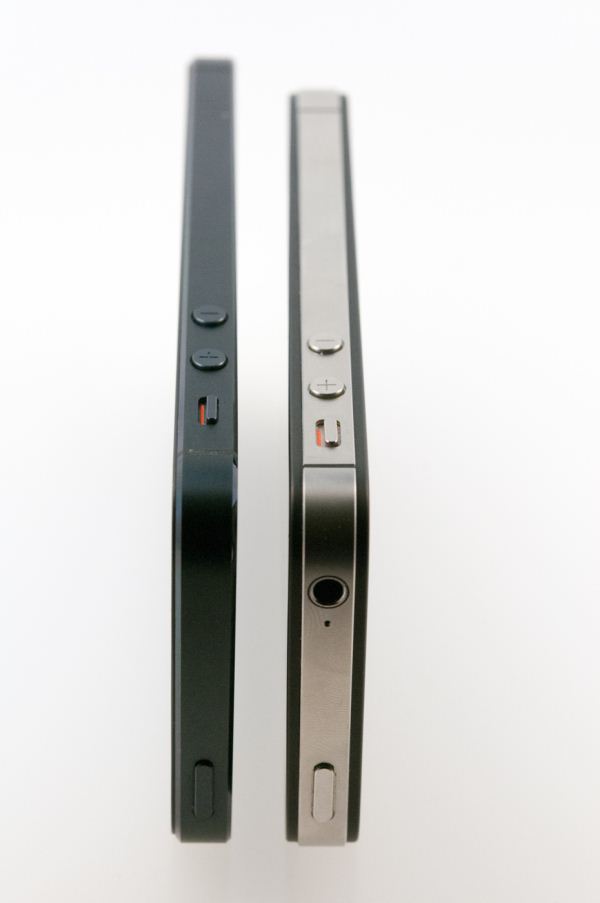The iPhone 5 Review
by Anand Lal Shimpi, Brian Klug & Vivek Gowri on October 16, 2012 11:33 AM EST- Posted in
- Smartphones
- Apple
- Mobile
- iPhone 5
The last significant redesign of the iPhone platform came in 2010 with the iPhone 4. It was an update that literally touched all aspects of the device, from SoC to display to baseband and of course, chassis. Last month’s launch of the iPhone 5 is no different in magnitude. The sixth generation iPhone makes some of the biggest changes to the platform since its introduction in 2007.
Visually the device begins by evolving the design language of the iPhone 4/4S chassis. From the launch of the iPhone 4 it was quite obvious that Apple had picked a design it was quite proud of. Thus it’s not too surprising that, from a distance, the iPhone 5 resembles the previous two iPhone models. We’ll get into material differences shortly, but what make the iPhone 5 design such a radical departure is its larger display.
All previous iPhones have maintained the same 3.5-inch, 3:2 aspect ratio display. With the rest of the world quickly moving to much larger displays, and with 16:9 the clear aspect ratio of choice, when faced with the decision of modernizing the iPhone platform the choice was obvious.
The iPhone 5 embraces a taller, 4-inch, 16:9 1136 x 640 display opting to lengthen the device instead of increasing its area in both dimensions. The result is a device that is distinctly an iPhone, albeit a modern one. The taller display doesn’t do much to make desktop web pages any easier to read as a result of the width staying the same. Those longing for an HTC One X or Galaxy S 3 sized device running iOS are out of luck. Reading emails and typing are both improved though as there’s now more room for lists and the keyboard no longer occupies as much of the display. The taller device can be more awkward to use if you have smaller hands, but the added screen real estate is honestly worth it. Once you get used to the iPhone 5’s display, going back to the older models is tough.
The taller chassis went on a diet as well. The iPhone 5 is now considerably thinner and lighter than its predecessor, which is yet another factor that contributes to it feeling more modern.
Internally the device changes are just as significant, if not more, than those on the outside. The iPhone 5 includes LTE support, which in areas where LTE networks are deployed can be enough reason alone to warrant an upgrade.
The iPhone 5 also includes a brand new SoC from Apple: the A6. For the first time since the introduction of the iPad, Apple has introduced a major branded SoC on an iPhone first. The iPhone 4 used the A4 after it debuted on the iPad, and the 4S picked up the A5 months after the iPad 2 launched with it. The A6 however arrives first on the iPhone 5, and with it comes two of Apple’s first, custom designed CPU cores. We’ve always known Apple as a vertically integrated device and software vendor, but getting into CPU design takes that to a new level.
| Physical Comparison | ||||
| Apple iPhone 4S | Samsung Galaxy S 3 (USA) | HTC One S | Apple iPhone 5 | |
| Height | 115.2 mm (4.5") | 136.6 mm (5.38" ) | 130.9 mm (5.15" ) | 123.8 mm (4.87") |
| Width | 58.6 mm (2.31") | 70.6 mm (2.78") | 65 mm (2.56") | 58.6 mm (2.31") |
| Depth | 9.3 mm ( 0.37") | 8.6 mm (0.34") | 7.8 mm (0.31") | 7.6 mm (0.30") |
| Weight | 140 g (4.9 oz) | 133g (4.7 oz) | 119.5g (4.21 oz) | 112 g (3.95 oz) |
| CPU | Apple A5 @ ~800MHz Dual Core Cortex A9 | 1.5 GHz MSM8960 Dual Core Krait | 1.5 GHz MSM8260A Dual Core Krait | 1.3 GHz Apple A6 (Dual Core Apple Swift) |
| GPU | PowerVR SGX 543MP2 | Adreno 225 | Adreno 225 | PowerVR SGX 543MP3 |
| RAM | 512MB LPDDR2-800 | 2 GB LPDDR2 | 1 GB LPDDR2 | 1 GB LPDDR2 |
| NAND | 16GB, 32GB or 64GB integrated | 16/32 GB NAND with up to 64 GB microSDXC | 16 GB NAND | 16, 32, or 64 GB integrated |
| Camera | 8 MP with LED Flash + Front Facing Camera | 8 MP with LED Flash + 1.9 MP front facing | 8 MP with LED Flash + VGA front facing | 8 MP with LED Flash + 1.2MP front facing |
| Screen | 3.5" 960 x 640 LED backlit LCD | 4.8" 1280x720 HD SAMOLED | 4.3" 960x540 Super AMOLED | 4" 1136 x 640 LED backlit LCD |
| Battery | Internal 5.3 Whr | Removable 7.98 Whr | Removable 6.1 Whr | Internal 5.45 Whr |
There’s a lot to talk about when it comes to the new iPhone. Whether it is understanding the architecture of the A6 SoC or investigating the improved low light performance of the iPhone 5’s rear facing camera, we’ve got it here in what is easily our most in-depth iPhone review to date. Let’s get started.












276 Comments
View All Comments
OldAndBusted - Wednesday, October 24, 2012 - link
"I'm not an apple product owner, and never plan to be"That's actually kind of sad. That no matter what the product, you can't even consider it if it comes from Apple.
SolidusOne - Saturday, October 20, 2012 - link
How can you write page after page about geeky nuances, many of which cannot be discerned without lab equipment, and not utter a single word about the device's music player quality? This model particularly, as other reviews have said it was inferior to 4s in audio quality. ??????phillyry - Sunday, October 21, 2012 - link
Sorry but are you serious or trolling?Google search reveals nothing about this.
If you're serious then Engadget has an article for you that compares the sound quality of iPhone 5, GS3, One X, etc. with basically no appreciable difference. http://www.engadget.com/2012/10/02/iphone-vs-rival...
mshdk - Sunday, October 21, 2012 - link
What is the name of the IM app shown in the review?mohit2805 - Sunday, October 21, 2012 - link
Why Apple never goes for an inbuilt radio? why just its own ipod, when there are so many radio stations to listen to for free?Krysto - Tuesday, October 23, 2012 - link
The new Chromebook, which has a dual core 1.7 Ghz Cortex A15 CPU, reaches 668 points in Sunspider. That's compared to the 900+ for Apple's A6.darkcrayon - Wednesday, January 2, 2013 - link
Comparing a chip in a laptop to one in a smartphone.. A laptop with terrible battery life (for an ARM device) at a that. Nice work. Let us know when Apple puts an Ax chip inside of a small laptop and then let's compare performance.eanazag - Thursday, November 1, 2012 - link
I live in MN and have been using the maps app in iOS 6 on an iPhone 4 and iPad 3. I have encountered no issues with it. In fact it has been a little more accurate than the GPS I have and Google previously. I am guessing that in more urban areas there is a larger difference.I would have liked to see some more features that my GPS has, such as current speed, estimated arrival time, and remaining total miles for trip.
If I'm going to complain, wish they would have included turn-by-turn on the 4.
Coffeebean20 - Saturday, November 24, 2012 - link
Wow great review, I got my iPhone 5 free And tested it. I came up with similar results. Great review, good job :)cpu_arch - Wednesday, November 28, 2012 - link
Your block diagram of Swift is inaccurate, not because I know the block diagram of the Swift CPU, but because it fails to describe the basic out-of-order execution pipeline of any modern CPU's. Hint: instruction re-ordering is in the wrong place in your diagram.Your measurements of branch prediction microarchitecture performance are not useful. The key measurement is mispredict rate.
Also modern branch prediction is a function of branch outcome of the branch in question and prior branches, not some multiply/divide mechanism which you describe in your article.